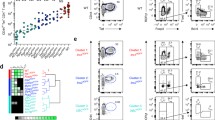Abstract
The murine class I major histocompatibility antigens play critical roles in the interaction of class I-restricted T cell receptors with their stimulatory or target antigen presenting cells. One approach taken by our laboratories has been to investigate the biological activity of genetically engineered, soluble, homogenous, purified class I molecules in the stimulation and inhibition of allospecific T cell hybridomas (Margulies et al, 1986; McCluskey et al, 1988; Schneck et al, 1989a). More recently we have established a system for comparing the role of the cell surface multivalent display of the MHC molecule with these monovalent soluble analogues expressed in vivo in transgenic mice. In this brief review, we hope to recount the logic by which the initial soluble class I MHC molecules were generated, summarize previously published as well as unpublished data on their expression and function, and present some preliminary evidence suggesting that transgenic mice expressing soluble analogues of the H-2Dd protein in a C57B1/6 background will be useful for studies of the molecular and biochemical basis of the generation of immunological tolerance to class I molecules.
Access this chapter
Tax calculation will be finalised at checkout
Purchases are for personal use only
Preview
Unable to display preview. Download preview PDF.
Similar content being viewed by others
References
Arnold B, Dill O, Küblbeck G, Jatsch L, Simon MM, Tucker J, and Hämmerling GJ (1988) Alloreactive immune responses of transgenic mice expressing a foreign transplantation antigen in a soluble form. Proc Nat Acad Sci USA 85: 2269–2273.
Berger EA, Fuerst, and Moss B (1988) A soluble recombinant polypeptide comprising the amino-terminal half of the extracellular region of the CD4 molecule contains an active binding site for human immunodeficiency virus. Proc Natl Acad Sci USA 85: 2357–2361.
Bevan MJ (1984) High determinant density may explain the phenomenon of alloreactivity. Immunol Today 5: 128–130.
Bjorkman PJ, Saper MA, Samroui B, Bennett WS, Strominger JL, and Wiley DC (1987) Structure of the human class I histocompatibility antigen, HLA-A2. Nature 329: 506–512.
Claverie J-M and Kourilsky P (1986) The peptide self model: a reassessment of the role of the major histocompatibility complex molecule in the restriction of the T-cell response. Ann Inst Pasteur Immunol 137D: 425–442.
Evans GA, Margulies DH, Shykind B, Scidman JG, and Ozato K (1982) Exon shuffling: mapping polymorphic determinants on hybrid mouse transplantation antigens. Nature 300: 755–757.
Hunziker R and Margulies DH (1989) Mice transgenic for a gene encoding a soluble, polymorphic major histocompatibility complex antigen. In: First N (ed) Transgenic animals. Butterworths, Stoneham, Mass (in press).
Kahn-Perles B, Barra C, Jehan J, Fourel D, Barad M, Maryanski JL, and Lemonnier FA (1989) Cytotoxic T lymphocyte recognition of secreted HLA class I molecules. J Immunol 142: 3021–3025.
Lew AM, Maloy WL, and Coligan JE (1986) Characteristics of the expression of the murine soluble class I molecule (Q10). J Immunol 136: 254–258.
McCluskey J, Boyd LF, Highet PF, Inman J, and Margulies DH (1988) T cell activation by purified, soluble, class I MHC molecules, requirement for polyvalency. J Immunol 141: 1451–1455.
Margulies DH, Evans GA, Ozato K, Camerini-Otero RD, Tanaka K, Appella E, and Scidman JG (1983) Expression of H-2Dd and H-2Ldmouse major histocompatibility antigen genes in L cells after DNA-mediated gene transfer. J Immunol 130: 463–470.
Margulies DH, Lopez R, Boyd LF, and McCluskey J (1987) Engineering soluble major histocompatibility molecules: why and how. Immunol Res 6: 101–116.
Margulies DH and McCluskey J (1985) Exon shuffling: new genes from old. Surv Immunol Res 4: 146–159.
Margulies DH, Ramsey AL, Boyd LF and McCluskey J (1986) Genetic engineering of an H-2Dd/Q10b chimeric histocompatibility antigen: purification of soluble protein from transformant cell supernatants. Proc. Nat. Acad. Sci. U.S.A. 83: 5252–5256.
Matzinger P and Bevan MJ (1977) Why do so many lymphocytes respond to major histocompatibility antigens? Cell Immunol 29: 1–5.
Munitz TI, Schneck J, Coligan JE, Maloy WL, Henrich JP, Sharrow SO, Margulies DH, and Singer A (1989) A peptide derived from the alpha-helical region of class I MHC blocks CTL engagement of the class I MHC molecule. Cold Spring Harbor Symp Quant Biol 54: in press.
Potter T, Raj an TV, Dick RF, and Bluestone J A (1989) Substitution at residue 227 of H-2 class I molecules abrogates recognition by CD8-dependent, but not CD8-independent, cytotoxic T lymphocytes. Nature 337: 73–75.
Salter RD, Norment AM, Chen BP, Clayberger C, Krensky AM, Littman DR, and Parham P (1989) Polymorphism in the α3 domain of HLA-A molecules affects binding to CD8. Nature 338: 345–347.
Sayre PH, Hussey RE, Chang HC, Ciardelli TL, Reinherz EL (1989) Structural and binding analysis of a two domain extracellular CD2 molecule. J Exp Med 169: 995–1009.
Schneck J, Maloy WL, Coligan JE, and Margulies DH (1989a) Inhibition of an allospecific T cell hybridoma by soluble class I proteins and peptides: estimation of the affinity of a T cell receptor for MHC. Cell 56: 47–55.
Schneck J, Munitz T, Coligan JE, Maloy WL, Margulies DH, and Singer A (1989b) Inhibition of allorecognition by an H-2Kb-derived peptide is evidence for a T cell binding region on an MHC molecule. Proc Nat Acad Sci USA: in press.
Yoshioka T, Bieberich C, Scangos G, and Jay G (1987) A transgenic class I antigen is recognized as self and functions as a restriction element. J Immunol 139: 3861–3867.
Zuniga M and Hood L (1986) Clonal variation in cell surface display of an H-2 protein lacking a cytoplasmic tail. J Cell Biol 102: 1–10.
Author information
Authors and Affiliations
Editor information
Editors and Affiliations
Rights and permissions
Copyright information
© 1990 Springer-Verlag Berlin Heidelberg
About this paper
Cite this paper
Margulies, D.H. et al. (1990). Multivalent Requirement for the Stimulation of Alloreactive T Cells: Studies with Engineered Soluble MHC Class I Proteins In Vitro and In Vivo. In: Egorov, I.K., David, C.S. (eds) Transgenic Mice and Mutants in MHC Research. Springer, Berlin, Heidelberg. https://doi.org/10.1007/978-3-642-75442-5_6
Download citation
DOI: https://doi.org/10.1007/978-3-642-75442-5_6
Publisher Name: Springer, Berlin, Heidelberg
Print ISBN: 978-3-642-75444-9
Online ISBN: 978-3-642-75442-5
eBook Packages: Springer Book Archive




